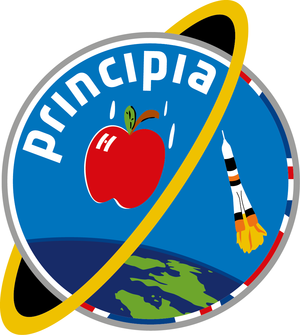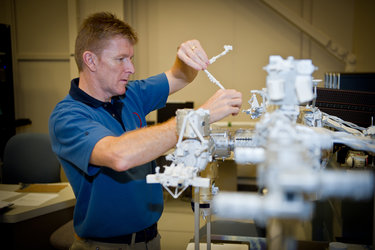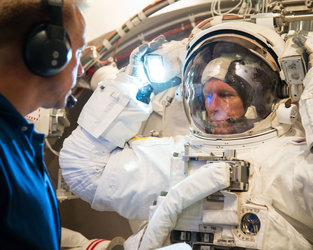Education: inspiring children
ESA astronaut Timothy Peake invites students of all ages to share the trip and the excitement of his space adventure. Principia’s large education and outreach programme includes more than 25 activities and teaching resources that will help to trigger the interest of students in science, technology, engineering and maths before, during and after the mission.
Biology and Rocket science
ESA astronaut Andreas Mogensen flew to the Space Station in September with a very special cargo for Tim: two kilograms of rocket seeds, a popular ingredient in salads, also known as rucola.

The seeds will be stored on board, orbiting the planet at 28 000 km per hour and exposed to the weightlessness and radiation of space. After several months, the seeds will be returned to Earth to be distributed across 10 000 schools in the UK, alongside with another batch of the same cultivar that had not left the planet.
Schoolchildren will plant the seeds and compare the growth of the two sources. The pupils will discover whether space travel has affected their growth, and whether humans could one day produce their own food in space.
Read more on the Rocket Science website.
Computing: Astro Pi

Primary and secondary schools in the UK are turning to the ‘Raspberry Pi’ minicomputer to learn programming and computing. Two of these credit card-sized Astro Pi computers equipped with a host of sensors and gadgets will be uploaded to the Station. Students have the chance to devise and code their own apps or experiments to run in space.
During his mission, Tim Peake will deploy the tiny computers in different locations. He will load up the winning codes, set them running, collect the data generated and then download it to Earth.
Five themes are set to stimulate the students’ creativity and scientific reasoning: spacecraft sensors, imaging and remote sensing, environmental measurements, data fusion and space radiation.
Space science: watch and learn


Access the video
How do you explain gravity in the classroom? Tim joins the efforts of teachers on Earth in the quest to explain physics to their pupils. The astronaut will record videos from the Space Station demonstrating phenomena that mentors find hard to show during their Earthbound lessons.
A suite of resources for teachers includes demonstrations on gas particle motion, conservation of momentum, harmonics and planetary motions. The experiments will help students to understand Newton’s three laws of motion and the idea of gravitational forces – the inspiration behind Tim’s mission name, Principia.
Some lucky students and teachers will also have the chance to see and talk to the astronaut through live video calls from the Station. Tim will connect with the classroom for a few minutes to answer the pupils’ questions.
Talking from space

Space technology is not all high-tech. Radios operated by amateur enthusiasts can be used to communicate with the Space Station. As he flies above the UK, Tim will talk to children using handheld radios over ARISS, the Amateur Radio on the International Space Station.
An ARISS conversation usually last for about 10 minutes, which is the window when the Station flies over a certain area and radio contact is possible from orbit. During that time, students will be able to ask him questions about his life and work in space. Tim will use the amateur radio callsign GB1SS.
Fitness: Mission-X

Mission-X fever keeps spreading across the planet. Future space explorers will get on their marks and invade gyms to train like astronauts for the 2016 challenge. ‘Mission-X: Train like an astronaut’ is an educational programme in which thousands of schoolchildren aged 8 to 12 years from more than 25 countries do science activities and learn how to get fit.
Tim will kick off the worldwide challenge talking about regular exercise and nutrition, both on Earth and in space. He will take questions, give tips on having a healthy lifestyle and share his experiences in weightlessness.
Healthy living healthy food
Astronauts consume a varied diet and exercise at least for two hours per day to maintain their health and avoid the harmful effects of space on their body, such as bone and muscle loss.
Michelin-star chef Heston Blumenthal has created food for Tim’s mission. Heston’s journey to create the best dining experience for the astronaut relied on the help of schoolchildren joining “The Great British Space Dinner” competition. Get a taste of the unique British-inspired menus Tim and Heston chose for the Principia mission.
- Space Fuel
- Soup in a shell of brown bread
- Sunday roast in a helmet-shaped pie
- Bite-sized treats in the shape of planets
- Big Breakfast Launch
- Full English breakfast in the guise of a big square burger
- Space Menu
- Tomato and rocket soup
- British beef stew with asteroid dumplings
- Chocolate mousse with space dust
- Rocket Lolly
- Tomato and basil soup
- Spicy mackerel curry
- Eton mess
- Nova Tiffin Capsule
- Spicy fusion food
- Rhubarb and custard dessert







 Tim Peake on Facebook
Tim Peake on Facebook Tim Peake on YouTube
Tim Peake on YouTube Tim Peake on Flickr
Tim Peake on Flickr